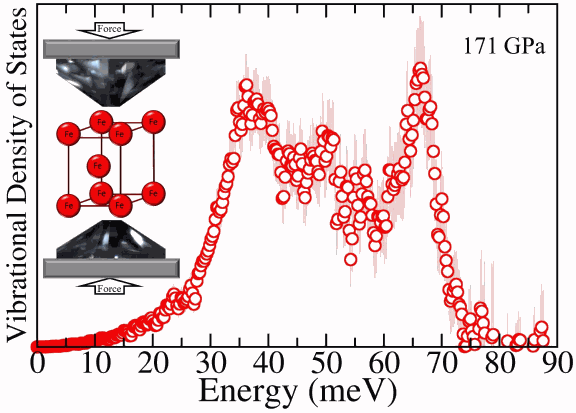The highest-pressure vibrational spectrum of iron has been obtained by researchers working at the U.S. Department of Energy Office of Science’s Advanced Photon Source at Argonne National Laboratory, providing important new clues to the behavior of iron in the Earth’s core.
“Pinpointing the properties of iron is the gold standard—or I guess ‘iron standard’—for how the core behaves,” said Jennifer Jackson, assistant professor of mineral physics at Caltech and coauthor of the study, which appears in the December 20 issue of Geophysical Research Letters. “That is where most discussions about the deep interior of the Earth begin. The temperature distribution, the formation of the planet—it all goes back to the core.”
To learn more about how iron behaves under the extreme conditions that exist in the Earth's core, the team used diamond anvil cells (DACs) to compress tiny samples of the element. DACs use two small diamonds to squeeze the iron, reproducing the types of pressures that exist at the Earth's core. These particular samples were pressurized to 171 Gigapascals (GPa), which is 1.7-million times the pressure we feel on the surface of the Earth.
To complete the experiments, the team took the DACs to the X-ray Science Division 3-ID x-ray beamline at the Advanced Photon Source, where they used powerful, high-brightness x-rays to measure the vibrational density-of-states of compressed iron. This information allowed the researchers to determine how quickly sound waves move through iron and compare the results to seismic observations of the core.
"The vibrational properties that we were able to measure at extraordinarily high pressures are unprecedented," said Jackson. "These pressures exist in the Earth’s outer core, and are very difficult to reproduce experimentally."
Caitlin Murphy, a graduate student in Jackson's group and first author of the paper, says the group was happy to find that their data set on the vibrational properties of iron evolved smoothly over a very wide pressure range, suggesting that their pressure-dependent analysis was robust, and that iron did not encounter any phase changes over this pressure range. To help achieve these successful measurements at high pressures, the group used some innovative techniques to keep the iron from thinning out in the DACs, such as preparing an insert to stabilize the sample chamber during compression. Additionally, they measured the volume of the compressed iron sample in situ and hydrostatically loaded the iron sample with neon into the sample chamber.
"These techniques allowed us to get the very high statistical quality we wanted in a reasonable amount of time, thus allowing us to obtain accurate vibrational properties of compressed iron, such as its Grüneisen parameter," said Jackson. "The Grüneisen parameter of a material describes how its total energy changes with compression and informs us on how iron may behave in the earth’s core. It is an extremely difficult quantity to measure accurately."
The team was also able to get a closer estimate of the melting point of iron from their experiments—which they report to be around 5800K at the boundary between the Earth’s solid inner core and liquid outer core. This information, combined with the other vibrational properties they found, gives the group important clues for estimating the amount of light elements, or impurities, in the core. By comparing the density of iron at the relevant pressure and temperature conditions with seismic observations of the core's density, they found that iron is 5.5% more dense than the solid inner core at this boundary.
"With our new data on iron, we can discuss several aspects of the Earth's core with more certainty and narrow down the amount of light elements that may be needed to help power the geodynamo—the process responsible for maintaining the Earth's magnetic field, which originates in the core," said Jackson.
According to Murphy, the next step is to perform similar experiments alloying iron with nickel and various light elements to determine how the density and, in particular, the vibrational properties of pure iron are affected. In turn, they will be able to evaluate the amount of light elements that produce a closer match to seismic observations of the core.
"There are a few candidate light elements for the core that everyone is always talking about—sulfur, silicon, oxygen, carbon, and hydrogen, for instance," said Murphy. "Silicon and oxygen are a few of the more popular, but they have not been studied in this detail yet. So that's where we will begin to expand our study."
See: Caitlin A. Murphy1, Jennifer M. Jackson1*, Wolfgang Sturhahn2‡, and Bin Chen1‡‡, “Grüneisen parameter of hcp‐Fe to 171 GPa,” Geophys. Res. Lett 38, L24306 (2011). DOI:10.1029/2011GL049531, 2011
Author affiliations: 1California Institute of Technology, 2Argonne National Laboratory,
‡Present address: Jet Propulsion Laboratory, ‡‡Present address: University of Michigan
Correspondence: * [email protected]
This research was supported by the U.S. National Science Foundation CAREER-0956166, and Caltech. Use of the Advanced Photon Source at Argonne National Laboratory was supported by the U.S. Department of Energy’s Office of Science under Contract No. DE-AC02-06CH11357.
The Advanced Photon Source at Argonne National Laboratory is one of five national synchrotron radiation light sources supported by the U.S. Department of Energy’s Office of Science to carry out applied and basic research to understand, predict, and ultimately control matter and energy at the electronic, atomic, and molecular levels, provide the foundations for new energy technologies, and support DOE missions in energy, environment, and national security. To learn more about the Office of Science x-ray user facilities, visit http://science.energy.gov/user-facilities/basic-energy-sciences/.
Argonne National Laboratory seeks solutions to pressing national problems in science and technology. The nation's first national laboratory, Argonne conducts leading-edge basic and applied scientific research in virtually every scientific discipline. Argonne researchers work closely with researchers from hundreds of companies, universities, and federal, state and municipal agencies to help them solve their specific problems, advance America's scientific leadership and prepare the nation for a better future. With employees from more than 60 nations, Argonne is managed by UChicago Argonne, LLC for the U.S. Department of Energy's Office of Science.

